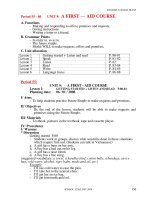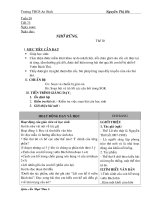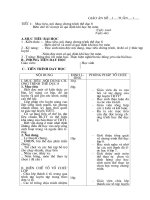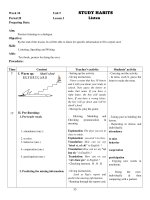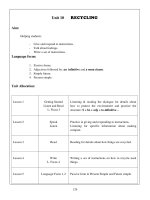Giao An 8 U3-5
Bạn đang xem bản rút gọn của tài liệu. Xem và tải ngay bản đầy đủ của tài liệu tại đây (204.51 KB, 23 trang )
Week 6 Unit 3 AT HOME
Period 17 Lesson 5 Write
Aim:
Practicing writing a description of a room.
Objective:
By the end of the lesson, Ss will be able to write a description of a room in their house.
Skill:
Writing and Speaking.
Aids:
Text-book, posters.
Procedure:
Time Content Teacher’s activity Students’ activity
5’
8’
10’
14’
I. Warm up: Chatting
Questions:
a. Which room is this ?
b. Telling me the things you know in
this room.
Keys: the bed, the clock, the table, the
chair, the shelf, the books, ….
II. Pre-writing:
1. Pre-teach vocab.
1. a folder:
2. beneath (pre.)
3. a dish-rack:
4. a lighting fixture
5. a wardrobe:
2. Answering the questions:
a. What is on the left of the room ?
b. Where is the bookshelf ?
c. What is there on the right of the
room ?
d. What is there on the table ?
III. While-writing: (Exer. 2 P.33)
- Setting up the activity.
- Giving instructions.
Look at the picture on page
32 and answer the questions.
- Asking the questions.
- Eliciting, Modeling, Checking
pronunciation & meaning.
Realia: This is a folder.
Translation: How can we say
“beân döôùi” in English ?
Picture: What do you call this
picture in English ?
Picture: This is a lighting
fixture.
Picture: This is a wardrobe.
- Checking memory: R . O . R
- Giving instructions.
Read the description of Hoa’s
room and answer the questions.
- Monitoring & assisting.
- Feeding back.
- Giving instructions.
Now use the words given in
- The whole class take part in
the activity.
- Taking part in building the
lesson.
- Repeating in chorus &
individually.
a folder
beneath
a dish-rack
a lighting fixture
a wardrobe
- Copying new words in
notebooks.
- Reading the description of
Hoa’s room and answering the
questions.
- Working indivi. and then
comparing with a partner.
- Working in 4 groups to write
33
7’
1’
Model:
This is Hoa’s kitchen.
There is the refrigerator in the right
corner of the room. Next to the refrigerator
are the stove and oven. On the other side of
the oven there is a sink and next to the sink
is a tower rack.
The dish rack is on the counter next to the
right side of the window and beneath the
shelves. On the shelves and on the counter
beneath the window, there are jars of sugar,
flour and tea…..
IV. Post-writing:
Correction of the passages of the
groups.
V. Homework:
Writing the descriptions of living-rooms
or bedrooms in your house.
the exer. 2, page 33 to write a
description of the kitchen.
Work in 4 groups. The group
that has the least mistakes and
is the fastest will be the winner.
- Monitoring & assisting.
- Correcting the mistakes of the
Ss’ descriptions.
- Setting the task for Ss.
- Giving instructions.
Write the description of
living-rooms or bedroom in
your house.
the description of the kitchen
on the posters.
- Hanging the posters on the
board.
- Correcting the descriptions
with teacher.
- Taking notes in notebooks.
Week 6 – 7 Period Test
Period 18-19
Aim:
Checking Ss how to use the vocabulary and the grammars structures that have learnt
Objective:
By the end of the test, students will be able to remember the vocabulary & use the grammar structures more
fluently.
Skill:
Writing, Reading and Listening.
Aids:
Test papers.
Procedure:
Name: TEST ONE
Class: English 8 Marks
I. Choose the best answer firm a, b, c, d: (3ms)
1. It is ………… to leave medicine and chemicals around the house.
a. interesting b. hard c. dangerous d. safe
2. The place where the children without parents live is called ………….
a. bus – stop b. orphanage c. petrol – station d. school
3. The synonym of “sociable” is …………………..
34
a. reserved b. kind c. generous d. outgoing
4. He was French although he later ………….. to the United States.
a. emigrated b. moved c. born d. transmitted
5. You can use a ………. to receive the message when you are out .
a. mobile b. telephone directory c. answering machined. address book
6. You use a ……………. to cook rice.
a. steamer b. rice – cooker c. saucepan d. frying pan
7. I’m sorry I have to be out, so you must cook dinner …………..
a. alone you b. yourself c. myself d. on you
8. No. She is not ……………… to do this job.
a. experienced b. enough experienced c. enough d. experienced enough
9. Last year, Lan ……….. in Hue.
a. lives b. lived c. is living d. was living
10. Children …………… play with matches.
a. should b. shouldn’t c. ought to d. have to
11. The moon ……………… around the sun.
a. didn’t move b. doesn’t move c. wasn’t moving d. don’t move
12. A …………… is the person who can neither speak nor hear.
a. deaf – mute b. boy c. assistant d. engineer
13. I will come and pick you ………. at 4 o’clock tomorrow.
a. up b. over c. above d. under
14. She has to …………..to the dentist’s.
a. going b. went c. goes d. go
15. Would you like ………….her a message.
a. to leave b. leaving c. leave d. to be left
II. Read the passage carefully and choose the best answers for the questions below: (2,5ms)
Alexander Graham Bell was born in Edinburgh, Scotland in the nineteenth century, and later came to
the United States. Several members of his family did a great deal to encourage him to the field of science. His
father helped him a lot by supervising his work with the deaf. When he worked with the deaf and investigated
the science acoustics, his studies eventually led to invention of multiple telegraph and his greatest invention –
the telephone. He dedicated the last quarter century of his life to advances in aviation.
Notes: aviation: hàng không , acoustics: âm học, dedicate: cống hiến
Questions:
1. What was Alexander Graham Bell’s greatest invention ?
a. multiple telegraph b. telephone c. aviation d. acoustics
2. To what did Bell dedicate the last years of his life ?
a. acoustics science b. aviation c. adventure d. architecture
3. How many years did Bell dedicate to aviation ?
a. 100 b. 50 c. 35 d. 25
4. What can we conclude about Alexander Graham Bell ?
a. He worked very hard, but he never succeeded.
b. He spent so many years working in aviation because he wanted to be a pilot.
c. He dedicated his life to science and the well-being of mankind.
d. He worked with the deaf so that he could invent the telephone.
35
5. Which of the following is Not True ?
a. Bell was born in the 18
th
century. b. Bell worked with the deaf.
c. Bell experimented with the science of acoustics. d. Bell invented a multiple telegraph.
III. Part 3 - Writing: Do the exercises as directed in the brackets (2,5ms):
1. The television / be / shelf / next / lamp. (Make the complete sentence)
--- > …………………………………………………………. ……………………………………………………………………………………………………………….
2. The boy isn’t very tall. He can’t play volleyball. (Combine into one, using ENOUGH)
--- > …………………………………………………………. ……………………………………………………………………………………………………………….
3. Nam failed his English test because he didn’t study hard. (Make a question with: Why)
--- > …………………………………………………. ……………………………………………………………………………………………………………….
4. Nga has a movie ticket. (Finish the sentence below with your own words).
--- > Nga is going………………………………. ……………………………………………………………………………………………………………….
5. The garbage is full. (Finish the sentence below with your own words).
--- > He must…………………………. ………………………………………………………………………………………………………………………………
IV. Part 4 – Listening: Listen and choose the correct answer: (2ms)
1. Date: ……………………………
a. December 13
th
b. December 30
th
c. September 13
th
d. September 30
th
2. Time: ……………………………
a. 8 o’clock. b. 18 o’clock c. After lunch d. After dinner
3. For: ………………………………… a. the principal, Mr. Ba b. the doctor, Mr. Ba
c. the customer d. the manager, Mr. Ba
4. Taken by: ……………………………………
a. the assistantb. the student c. the patient d. the seller.
The end
• Keys:
I. 1.c 2.b 3.d 4.a 5.c 6.b 7.c
8.d 9.b 10.b 11.b 12.a 13. 14.d 15.a
II. 1.b 2.b 3.d 4.c 5.a
III. 1. The television is on the shelf next to the lamp.
2. The boy isn’t tall enough to play volleyball.
3. why did Nam fail his English test ?
4. Nga is going to see a movie.
5. He must empty the garbage.
IV. 1.b 2.b 3.b 4.a
• Comments:
• Result:
Mark
Class
0 ---- >4.9 5 ---- >6.4 6.5 ---- >7.9 8 --- >10
36
Unit 4: OUR PAST
Aim:
Helping students:
- Talk about past events.
- Express feelings.
- Distinguish between facts & opinion
- Write a short imaginary story.
Language focus:
1. Simple past tense .
2. Prepositions of time: in, on, at, after, before, between (review)
3. Structure with: Used to.
Unit Allocation:
Lesson 1 Getting Started
Listen and Read –
Lang Focus 1
Listening & reading the dialogue about the life many
years ago.
Lesson 2 Speak Practice talking about the way things used to be & the
way they are now.
Lesson 3 Listen Listening to the story for the main idea.
Lesson 4
Read Reading the story “The lost shoe”.
Lesson 5 Write Writing a passage a short imaginary story.
Lesson 6 Language focus Further Practice using the prepositions of time, the
simple past & structure with: Used to
37
Week 7 Unit 4 OUR PAST
Period 20 Lesson 1 Getting Started – Listen & Read
Aim:
Reading the dialogue about the life in many years ago.
Objective:
By the end of the lesson, Ss will be able to use the structure with: Used to and know about the life in the past.
Skill:
Reading, Speaking and Listening.
Aids:
Text book, pictures .
Procedure:
Time Content Teacher’s activity Students’ activity
4’
20’
I. Warm up: (Getting Started)
Possible keys:
- the TV, the radio, the mobile phone
- the lighting fixture, the modern
clothes.
- The school uniforms, ……
II. Presentation:
1. Pre-teach vocab.
1. to look after:
2. equipment (unc.) :
3. a folk tale:
5. Great-grandma
2. Set the scene:
3. Guiding questions:
a. Did grandma live in the city when
she was young ?
b. Did she go to school ?
- Setting up the activity.
- Giving instructions.
Look at the picture in your books
and write the things that do not
belong to the past.
Work in 2 groups to write the
things on the board. In 3 minutes
the group has more and right
things will be the winner.
- feeding back.
- Eliciting, Modeling, Checking
pronunciation & meaning.
Synonym: give me the synonym of
“to take care of”
Example: Washing-machine,
electric fan,….. are the equipment.
Example: Tam Cam, So Dua……
are folk tales
Explanation: What do you call the
mother of your grandparents ?
- Checking memory: R . O . R
- Setting the scene.
Nga’s Grandma is talking to her
about her past time. Now guess the
answers for 2 questions.
- Writing Ss’ answers on the
board.
- Taking part in the activity.
- Working in pairs then in 2
groups.
- Taking part in building the
lesson.
- Repeating in chorus &
indivi.
to look after
equipment
folk tale
great-grandma
- Copying new words in
noteb.
- Listening to the teacher &
guessing the answers in
pairs.
38
8’
10’
3’
4. Listen and answer:
(tape transcript in teacher’s book)
5. Listen and repeat:
6. Practice with a partner:
7. Language focus:
She used to live on a farm.
S + used to + infinitive ……
Usage: expressing an action that
happened in the past and no longer
happened in the present.
III. Practice: Word-cue drill
Model:
S
1
: Did you use to live in Hue ?
S
2
: No. I used to live in Hanoi.
a. live / Hue / Hanoi.
b. have / long hair / short hair.
c. get up / late / early.
d. walk to school / go by bus.
IV. Production:
(Exer. 2 P. 39)
Keys:
a. She used to live on a farm.
b. She had to stay at home and
helped her mother.
c. Nga’s great grandmother used to
cook the meals, clean the house …
d. They lit the lamp and told stories.
e. She asked her to tell the tale.
V. Homework:
(Exer. 3 on page 39).
Model:
F O
- Letting Ss listen to the tape
twice.
- Letting Ss listen to the tape the
third.
- Giving feed back.
- Letting Ss listen to the tape
again.
- Asking Ss to practice in pairs.
- Setting the scene to introduce the
new target lang. by asking the
question: where did grandma live
when she was young ?
- Presenting new target language
- Checking concept.
Meaning: Tell me the Vietnamese
meaning of the sentence.
Form: How to form this pattern ?
Use: What is the pattern used for ?
Pronunciation. How do we
pronounce used to ?
- Giving instructions.
Use the cues to make the
complete sentences with Used to.
- Running through the cues.
- Modeling.
- Monitoring & assisting.
- Feeding back
- Setting up the activity.
- Giving instructions.
Read the dialogue again and give
the answers for the questions on
page 39.
- Modeling.
- Monitoring & assisting
- Feeding back.
- Setting the task for Ss.
- Giving instructions.
Read the sentences in the exer. 3
- Giving teacher the answers.
- Listening to the tape &
checking the answers.
- Comparing the answers
with a partner.
- Correcting the wrong
answers
- Repeating the dialogue.
- Practicing in close pairs.
- Listening and answering the
question.
- Answering the questions to
show how to know the new
target language.
- Copying the new target
lang. in notebooks.
- Listening & taking part in
the model with teacher.
- Practicing in close pairs and
then open pairs.
- Working in pairs to give the
answers for the questions.
- Correcting the wrong
answers.
- Taking notes in notebooks.
39
a. I used to live on a farm.
b. There wasn’t electricity.
on page 39 and decide which
sentences are Fact or Opinion.
- Modeling.
Week 7 Unit 4 OUR PAST
Period 21 Lesson 2 Speak
Aim:
Practice speaking the dialogue about the things in the past & in the present.
Objective:
By the end of the lesson, Ss will be able to talk about the ways things used to be and the way they are now.
Skill:
Speaking and Listening.
Aids:
Text book, pictures .
Procedure:
Time Content Teacher’s activity Students’ activity
5’
15’
I. Warm up: Jumbled words
Model:
acr ----- > car
• rieletcity ------ > electricity.
• menttaenterin ------ >
entertainment
• martke ----- > market
• permasuket ----- > supermarket
II. Pre-speaking: Guiding questions.
1. Where did they live in the past ?
and now ?
- Setting up the activity.
- Giving instructions.
Arrange these letters to make the
meaningful words.
Work in two groups
- Modeling.
- Feeding back.
- Congratulating.
- Setting up the activity.
- Giving instructions.
Look at the pictures on page 40
and work with a partner to answer
- Carrying in the activity.
- Working in two groups, in
turns, writing the correct
words on the board.
- Choosing the winner.
- Looking at the pictures and
working in pairs to answer
the questions.
40
10’
12’
3’
2. How did they travel ? and now ?
3. What about electricity in the
past ? and now ?
4. How did they work in the past ?
and now ?
5. Did the children go to school in
the past ? and now ?
6. What did the children play in the
past ? and now ?
III. While-speaking:
Keys:
1. They used to live in small houses,
and now they live in big houses or
building.
2. They used to walk, and now they
can travel by cars, motorbikes.
3. They didn’t used to have
electricity, and now the electricity is
everywhere.
4. They used to work hard, and now
they have a lot of time for
entertainment.
5. Most children used to stay at
home, and now they all go to school.
6. The children used to play
traditional games such as: Hide &
Sick, Skipping rope, …… Now they can
play modern games as video games.
IV. Post-speaking:
Model:
Last year, I used to get up late on
Sundays. I used to go fishing with my old
friends. I used to cook the meals myself…
V. Homework:
Writing 5 sentences about the things you
used to do in the past.
Model:
I used to eat hamburger.
the questions. Use Used to to talk
about the actions in the past.
- Modeling.
- Monitoring & assisting.
- Correcting & conducting the feed
back.
- Giving instructions.
Work in pairs to ask and answer
the questions about the things in
the past and the things at the
present.
- Monitoring & assisting.
- Feeding back.
- Setting up the activity.
- Giving instructions.
Now tell your partner about the
things you used to do last year.
- Modeling.
- Monitoring & assisting.
- Feeding back.
- Setting the task for Ss
- Giving instructions.
Write 5 sentences about the
things you used to do in the past.
- Modeling.
- Correcting if necessary.
- Practicing speaking in close
pairs and then open pairs.
- Practicing speaking in close
pairs.
- Practicing speaking in open
pairs.
- Taking notes in notebooks.
41
